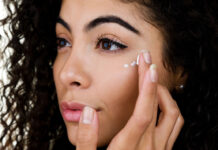We use sunscreen to block ultraviolet light from damaging the skin. There are two categories of UV light — UVA and UVB — that we consider in terms of sunscreen. UVB causes sunburn, and UVA has more long-term damaging effects on the skin, like premature aging. SPF, or sun protection factor, numbers were introduced in 1962 to measure a sunscreen’s effect against UVB rays.
To determine a sunscreen’s SPF, testers round up 20 sun-sensitive people and measure the amount of UV rays it takes them to burn without sunscreen. Then they redo the test with sunscreen. The “with sunscreen” number is divided by the “without sunscreen” number, and the result is rounded down to the nearest five. This is the SPF.
SPF numbers start at 2 and have just recently reached 70. To figure out how long you can stay in the sun with a given SPF, use this equation:
Minutes to burn without sunscreen x SPF number = maximum sun exposure time
For example, if you burn after 10 minutes of sun exposure, an SPF of 15 will allow you to be in the sun for up to 150 minutes without burning. But before you grab your calculator and head for the outdoors, you should know that this equation is not always accurate. People usually use far less sunscreen than the amount used in testing.

UVB ABSORPTION
So, now we know that a higher SPF number means more sun-exposure time. It also indicates the level of UVB absorption, but this number doesn’t increase exponentially, which can be confusing. For example, an SPF of 15 absorbs 93.3 percent of UVB rays, but an SPF of 30 absorbs 96.7 percent. The SPF number has doubled, but the absorption rate has increased by only 3.4 percent.
We now know that most of us apply only about half the required amount of sunscreen. Also, despite waterproof or sweatproof labels, all sunscreens decrease in effectiveness when exposed to water or sweat. If you don’t apply the correct amount and then reapply after exposure to water, a 12-hour bake in the sun could give you a very serious sunburn.
| SPF | % UV absorbed |
|---|---|
| 2 | 50 |
| 4 | 70 |
| 8 | 87.5 |
| 15 | 93.3 |
| 30 | 96.7 |
| 50 | 98 |

HIGH-SPF SUNSCREENS: ARE THEY BETTER?
The actual SPF one achieves is approximately 1/3 of the labeled value.
The best sunscreen is the one you’ll use regularly.
UV radiation reaches the earth in the form of UVB and UVA rays. UVB radiation plays a key role in skin cancer, and SPF refers mainly to the amount of UVB protection a sunscreen offers. Thus, higher SPFs can help: An SPF 15 sunscreen blocks 93 percent of UVB radiation, while an SPF 30 sunscreen blocks nearly 97 percent. Furthermore, higher SPF values offer some safety margin, since consumers generally do not apply enough sunscreen. To evaluate SPFs, testers apply two milligrams of sunscreen per square centimeter of skin. But in everyday life, most people apply from only 0.5 to one milligram per square centimeter of skin. Consequently, the actual SPF they achieve is approximately 1/3 of the labeled value.
Despite these advantages, there are potential downsides to using products with very high SPFs.
First, above SPF 50 (which blocks an estimated 98 percent of UVB rays), the increase in UVB protection is minimal.
Second, although UVA protection is also important (UVA not only accelerates skin aging, but contributes to and may even initiate skin cancers), SPFs mainly measure UVB protection.
Individuals applying high-SPF sunscreens may not burn (UVB is the chief cause of sunburn), but without UVA-screening ingredients they can still receive large amounts of skin-damaging radiation. To avoid such a scenario, regulatory bodies in Europe and Australia have adopted UVA testing guidelines and measurement standards, and capped the SPF of sunscreens at 50+. The US Food and Drug Administration (FDA) may do the same, but hasn’t to date.
Products with very high SPFs may also encourage individuals to neglect other photo protective behaviors, like seeking the shade and wearing sun-protective clothing. By preventing sunburn, sunscreens with very high SPFs can create a false sense of security, prompting consumers to stay out in the sun longer. Sun damage (for example, UVA damage) can take place without skin-reddening doses of UV radiation, and even the best sunscreens should be considered just one vital part of a comprehensive sun protection regimen.
But there are problems with the SPF model: First, no sunscreen, regardless of strength, should be expected to stay effective longer than two hours without reapplication. Second, “reddening” of the skin is a reaction to UVB rays alone and tells you little about what UVA damage you may be getting. Plenty of damage can be done without the red flag of sunburn being raised.
Many after-shave lotions and moisturizers have a sunscreen (usually SPF 15 or greater) already in them, and this is sufficient for everyday activities with a few minutes here and there in the sun. However, if you work outside or spend a lot of time outdoors, you need stronger, water-resistant, beachwear-type sunscreen that holds together on your skin. The “water resistant” and “very water resistant” types are also good for hot days or while playing sports, because they’re less likely to drip into your eyes when you sweat. However, these sunscreens may not be as good for everyday wear. They are stickier, don’t go as well with makeup, and need to be reapplied every two hours.
If it’s cold or cloudy outside, you don’t need sunscreen. This is not true. Up to 40 percent of the sun’s ultraviolet radiation reaches the earth on a completely cloudy day. This misperception often leads to the most serious sunburns, because people spend all day outdoors with no protection from the sun.
No perfect sunscreen exists
The best sunscreen is the sunscreen you like well enough that you’ll use it regularly.
While UVB rays affect skin primarily between 10am and 2-4 pm, UVA rays (which can penetrate skin more deeply and cause it to age it without you feeling its effects) work on your skin during all daylight hours.
A sunburn is the first acute thing you’re trying to prevent, then aging of the skin, then pre-cancers and skin cancers. The areas where we see the worst results of pre-aging and pre-cancers are the head, neck and the back of the hands. I recommend putting sunscreen on every day.”
A sunburn is the first acute thing you’re trying to prevent, then aging of the skin, then pre-cancers and skin cancers, The areas where we see the worst results of pre-aging and pre-cancers are the head, neck and the back of the hands. Experts recommend putting sunscreen on every day.

WHEN TO CHOOSE SPF 50 OR 50+
Use high SPF sunscreens on thin-skinned areas such as your nose, ears and backs of hands. It’s also a good to use on any exposed skin when exploring at high altitude, polar regions or areas of intense sun exposure (including reflective surfaces such as snow). Some users feel SPF 50 sunscreens feel heavier, greasier or less breathable on skin. They use SPF 30 or higher on sweat zones (arms and legs) and carry a separate tube of SPF 50 or 50+ to touch up thin-skinned areas.
SPF 15 sunscreen blocks 93% of UVB rays, SPF 30 blocks 97%. You’re not doubling your protection with the twice-as-high number. SPF 50 blocks 98%. No sunscreen can block 100% of solar energy. So any product labeled higher than SPF 50+ offers only a minuscule fraction of additional protection beyond 98%.
Use only shade to protect kids under 6 months of age because their skin can too easily absorb sunscreen. Adult sunscreen is fine to use on kids 6 months and older. Be vigilant to protect skin from excessive sun exposure. Bad sunburns early in life have been cited as contributors to cases of adult skin cancer.

PREVENTING SUN DAMAGE
A sunscreen with a higher SPF does offer higher protection against UVB rays, but once you get past SPF 30, protection doesn’t increase dramatically, and the higher number may give you a false sense of protection. Instead of letting SPF be your only guide to sun protection, avoid a burn by following a few simple sunscreen rules.
1. Know thyself:
If you are whiter than a sheet of paper, if your Aunt Linda has skin cancer, or if you are sensitive to the sun because of a medication or a medical condition, take extra measures. Stay out of the sun as much as possible, wear a hat when you are out, use a broad-spectrum sunscreen with a high SPF and reapply that sunscreen often.
2. Broaden your spectrum:
The SPF number indicates protection only against UVB rays — many sunscreens, even those with a high SPF, allow UVA rays to be absorbed by the skin. UVA protection is usually indicated by a “broad-spectrum” label. Look for this to ensure the most well-rounded sun coverage.
The high SPF numbers on some new sunscreens might not be that useful, but their protection against UVA rays will be. The skin absorbs UVA rays from the sun, tanning beds and sunlamps. These rays won’t give you a sunburn, but they can cause long-term skin damage. You should always use a broad-spectrum sunscreen to ensure protection from both UVA and UVB rays. The latest sunscreens boast new chemicals, like Mexoryl, which has proven to be one of the most effective UVA-blockers out there.
3. Here comes the sun:
To be effective, sunscreen needs to be fully absorbed into the skin, so apply it 15 to 30 minutes before you even step into the sun.
4. Reapply yourself:
Whether you’re lying by the pool or mowing the lawn, you’ll probably be exposed to sweat or water, the natural enemies of sunscreen. To be safe, reapply after you swim or sweat.
5. Full exposure:
No matter how high the SPF, sunscreen can protect only the skin it covers. The most commonly missed spots are the temples, ears, back of the neck and top of the feet. If you are sometimes guilty of losing your focus while applying your lotion, try one of the sunscreens that contains disappearing colorants, so you can identify un-lotioned areas before they burn to a crisp.
Active outdoor people should look for the following on sunscreen product labels:

WHAT’S YOUR NUMBER?
SPF rating:
SPF = Sunburn Protection Factor. It’s a gauge of the product’s effectiveness against sunburn-causing ultraviolet B (UVB) rays. If you are outside for long stretches (2+ hours), choose SPF 30 or higher.
Broad spectrum:
This indicates that a product is deemed effective against both UVB (skin-burning) and UVA (skin-aging) rays. UVA and UVB rays can also contribute to skin cancer, the most common cancer of all. If you see “broad spectrum” on a label, it’s a good thing.
Sweat- or water-resistant:
No sunscreen is waterproof, even though that term used to appear on product labels. Based on performance in lab tests, new Food and Drug Administration (FDA) guidelines now allow products to claim water (or sweat) resistance of either 40 or 80 minutes.

SUNSCREEN QUICK TIPS
Try a mineral-based sunscreen, which contains either zinc oxide or titanium dioxide. Mineral formulas vary in how smoothly they spread on your skin (some can be tough to rub in) and how much of a white patina they leave on your skin (some show noticeably, some leave almost no trace).
Unafraid of chemicals?
You have lots more choices and a broader range of prices.
Skin sensitivity or skin allergies?
Your better sunscreen choice is likely to be a mineral sunscreen. You may also want to steer clear of formulas that include alcohol or fragrances.

HOW TO APPLY SUNSCREEN?
Use a broad-spectrum sunscreen with an SPF rating of 15 or higher. Apply sunscreen 20 minutes before going out into the sun (or as directed by the manufacturer) to give it time to absorb into your skin. Apply it generously and regularly— about 1 ounce every 2 hours—and more often if you are swimming or perspiring. A small tube containing between 3 and 5 ounces of sunscreen might only be enough for one person during a day at the beach.
Do not forget about lips, ears, feet, hands, bald spots and the back of the neck. In addition, apply sunscreen to areas under bathing suit straps, necklaces, bracelets, and sunglasses. Keep sunscreen until the expiration date or for no more than 3 years, because the sunscreen ingredients might become less effective over time.
In addition, apply sunscreen to areas under bathing suit straps, necklaces, bracelets, and sunglasses. Keep sunscreen until the expiration date or for no more than 3 years, because the sunscreen ingredients might become less effective over time.









